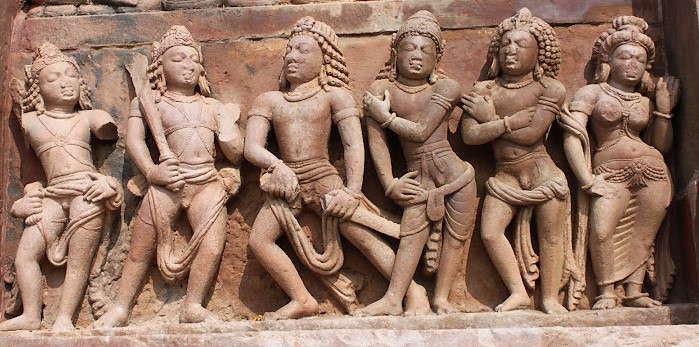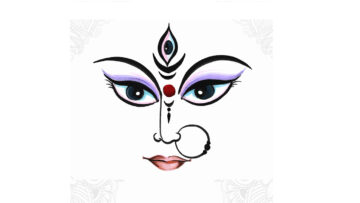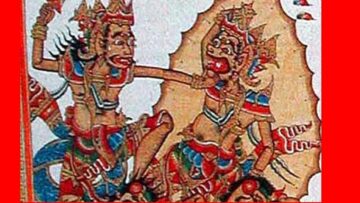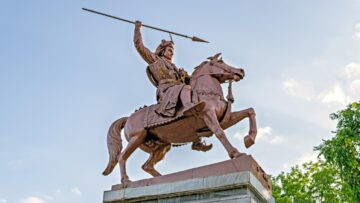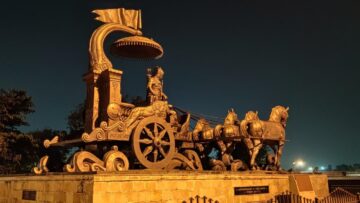Yudhishthira was firm on forsaking action (karma) lest he should commit another act of adharma. His thinking was driven by a belief that it was karma (action) that lay at the root of all the pain and suffering that he had to endure. Bhima and Arjuna spoke to him, to which Yudhishthira reiterated his plan of renunciation. What followed was a series of entreaties by the Pandavas, Droupadi, and others, each stressing in their own way the futility and inadvisability of renunciation.
One point repeatedly made was that it was the dharma of the householder that had been called by the wise as the most difficult among all –brahmacharya, garhasthya, vanaprastha, and sannyasa.
Arjuna recounted the story of some young brahmans who too had left for the forest, abandoning their village and parents. It was then that Indra took the form of a bird to counsel them that abandoning karma was against dharma, that the burden of a householder was the most difficult one, and urged them to abandon the path of a non-believer [12.11.27].
Nakula’s advice was not dissimilar from his brothers’, but was tempered by reason and respect; that the most perfect form of renunciation was to acquire wealth using dharmic ways and then to give it away in sacrifices [12.12.7]; through ashvamedha, rajasuya or sarvamedha sacrifices [12.12.26]. In other words, living life according to the dharma of the varna – artha, kaama, and heaven – was true renunciation [12.12.12]. While there were other forms of renunciation, they were more appropriate for brahmins, not for kshatriyas. Similar to what Arjuna had said, Nakula also spoke that the wise considered the garhasthya ashrama to be equal to the other three – brahmacharya, vanaprastha, and sannyasa – put together. This was because the wealth required for sacrifices was not easily available to someone immersed in the duties of a householder (garhasthya). What the king was contemplating was akin to abandoning the self and was tamasic in nature [12.12.8].
Sahadeva, the youngest Pandava, also spoke to Yudhishthira on renunciation. He echoed an even more philosophical point – that which is eternal and that which is death, both exist within ourselves (two syllables comprised मम – it is mine, and न मम comprised three syllables – it is not mine) [12.13.4], and while there could be a debate about the correct course of action, whatever he had told his brother arose from his love for him – for Yudhishthira was his father, his mother, his brother, and his guru (भवान्पिताभवान्माताभवान्भ्राताभवान्गुरुः)[12.13.12].
Droupadi was a proud woman, not given to mincing words. In that respect, she was similar to Bhima, and it was towards Bhima that she had turned to when Keechaka had kicked her in king Virata’s court. It was also Bhima who had killed Duhshasana and brought his blood for her to wash her hair with, to avenge the uncivilized act of him dragging her by her hair to king Dhritarashtra’s court. Vaishampayana tells Janamejaya that Droupadi had always been somewhat haughty towards Yudhishthira [12.14.4] (the word used is अभिमानवती). Her words reflected that attitude. She told Yudhishthira that it was because, he, the eldest brother had gone mad, so had the younger siblings [12.14.32], for if that were not the case, would they have not dispatched Yudhishthira along with other non-believers and ruled the earth themselves? She described Yudhishthira’s behaviour as one of a eunuch [12.14.13] (क्लीबस्य – is the same word– क्लैब्यं – that Krishna used for Arjuna in the Bhagavad Gita [6.24.3]), arising from madness that had afflicted him. Her entreaty to him was to rule the earth, perform sacrifices, and give to the brahmans. Droupadi also spoke briefly about the ‘staff of punishment’ (दण्ड), without which a kshatriya was incomplete.
Arjuna, following Droupadi’s lead, who had spoken briefly about punishment, expanded on the subject. The rod of punishment protected all, including dharma, artha, and kama [12.15.3]. Among other reasons, one motivation why the evil-minded do not commit crimes was fear of the king’s rod. For, without the fear of punishment, everything would be plunged into a blind darkness [12.15.32] and the strong would cook the weak much like the fish is cooked on a stake [12.15.30]. It was the fear of punishment that makes people to not renege on an agreement. The butcher of Mithila had once told sage Koushika that all activities, including agriculture and walking, involved some form of violence. In a discourse somewhat reminiscent of the Vyadha Gita in the Aranyaka Parva, Arjuna tried to disabuse Yudhishthira of his notions about violence and non-violence, telling him that Indra achieved fame by killing Vritra [12.15.15], as did Rudra, Skanda, Agni, Varuna, Yama, Vayu, Kuber, Surya, Vasus, Maruts, and others (the word used is हन्ता). Brahma, Dhata or Pushan, on the other hand, slayed no one, and that was the reason, according to Arjuna, that few people bowed before and worshipped these three.
The cycle of violence was universal – the mongoose ate the rat, which was eaten by the cat, which was eaten by the dog, which was eaten by a bigger carnivore, and finally all those were eaten by humans [12.15.21]. Even ascetics who lived in the forest ended up killing to sustain themselves, for there were beings in the water, earth, fruits, and even beings so small that their existence could only be inferred [12.15.26]. Arjuna made a very pertinent observation here, that between non-violence and violence (for righteous reasons), that which led to upholding of dharma was superior (अहिंसासाधुहिंसेतिश्रेयान्धर्मपरिग्रहः) [12.15.49]. This is, in my opinion, a more nuanced take on violence and non-violence as opposed to what we see later, in the Anushasana Parva, where a part of a shloka is oft-repeated, but distorted and often used out-of-context – अहिंसा परमो धर्म [13.116.1, where Yudhishthira ascribes the statement to Bheeshma; 13.116.25, uttered by Bhishma when extolling the virtues of giving up meat and the violence associated with it; and reiterated by Bhishma in 13.117.37].
In other words, there were no simplistic black and whites.
References:
- Debroy, Bibek. The Mahabharata, Vol. 8. Penguin India, 2013
- Bhandarkar Oriental Research Institute, Electronic text of the Mahabharata, 1999. (https://bombay.indology.info/ – last accessed Aug 27th, 2021)
- Sorensen, P. An Index to the Names in the Mahabharata. Motilal Banarsidas, 1978.
Disclaimer: The opinions expressed in this article belong to the author. Indic Today is neither responsible nor liable for the accuracy, completeness, suitability, or validity of any information in the article.

